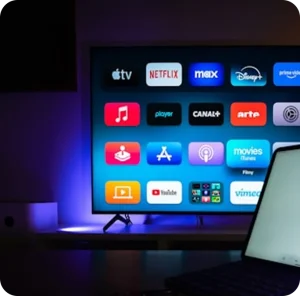The 1950s were known as the “golden age of television”—a time when TVs became mainstream household items. Thanks to advancements in mass production and affordability, televisions quickly found their place in living rooms across the world. And from there, the TV industry never looked back. Fast forward a few decades, and while traditional TV still has a presence, the way people watch content has drastically changed. In 2025, Connected TV (CTV) has taken over, becoming the go-to platform for streaming everything from hit series to sports and news. The biggest reason behind this shift? On-demand content and the affordability of smart TVs. With CTV, viewers aren’t tied to a schedule—they watch what they want, when they want. And this shift hasn’t just changed how we consume content—it’s also changing the advertising game. Advertisers are now seeing much better engagement on CTV platforms, making it one of the most effective ways to reach audiences. But what makes CTV advertising so effective? Before we dive into the results, let’s first understand what Connected TV advertising actually is. Everything You Should Know About Connected TV Advertising CTV advertising refers to the delivery of digital ads through smart TVs and other internet-enabled devices such as streaming sticks, set-top boxes, and gaming consoles. To fully grasp how CTV advertising works, it’s important to understand which devices fall under the CTV umbrella. Simply put, Connected TV refers to any television set that connects to the internet and allows users to stream content on-demand through apps and platforms like Netflix, Hulu, YouTube, and more. This includes smart TVs, streaming media players (like Roku or Fire TV), gaming consoles, and internet-connected set-top boxes. Are CTV and OTT the same? While the difference between traditional (linear) TV and connected TV is clear, there’s often confusion between CTV and OTT, a distinction that matters, especially in advertising. Here’s the key difference: CTV is the device (such as a smart TV) used to access content, while OTT (over-the-top) is the method of delivering that content via the internet to any device—TVs, phones, tablets, or desktops. Think of CTV as the screen, and OTT as the pipe delivering the show. In the context of advertising, all ads delivered specifically to internet-connected TVs are categorized as Connected TV advertising. CTV Ad Formats Advertisers can choose from several CTV ad formats to suit different campaign goals. These include: In-Stream Video Ads – These are full-screen ads that play before, during, or after streaming content, much like traditional TV commercials. Non-Linear Ads – Displayed alongside or over video content, these ads don’t interrupt the viewing experience but maintain visibility. Interactive Ads – These encourage viewer interaction, such as selecting an option, scanning a QR code, or exploring product details on-screen. Home-Screen Static Ads – Shown on the smart TV’s home screen, these banner or tile ads appear before content selection and are ideal for grabbing attention early. The Stats Behind CTV’s Rapid Rise CTV has seen explosive growth over the past two decades—and the numbers speak for themselves. While its origins trace back to the 1990s, CTV’s adoption truly accelerated in the early 2000s. Today, it stands as one of the most dynamic and rapidly expanding channels in digital media, especially in the U.S. market. Globally, the rise of CTV has been remarkable. By 2022, the number of connected TV users worldwide surpassed 1.1 billion. But it’s in the U.S. where CTV’s momentum is most striking. The U.S. alone accounted for 238 million monthly CTV viewers, making it the largest and most mature CTV market. This surge in viewership has driven major gains in CTV ad spending and revenue: CTV Global Revenue is projected to grow from $35.2 billion in 2024 to $46.3 billion by 2026. CTV Ad Spend is expected to exceed $42 billion globally by 2028, fueled by increased advertiser interest and better measurement capabilities. In the U.S., CTV accounts for over one-third of total TV usage, with projections indicating 238 million viewers by 2025. On average, U.S. adults watched 123.4 minutes of CTV per day in 2024, highlighting just how embedded CTV has become in daily media consumption. These numbers underline why advertisers can’t afford to overlook it. Why Are Leading Advertisers Choosing CTV?? The numbers above make it clear—CTV advertising isn’t something today’s advertisers can afford to ignore. But it’s not just the stats that highlight its importance. The real value lies in the unique benefits that CTV offers—benefits that make it a must-have in any media strategy. Here’s why CTV advertising is turning heads: High Completion Rates and Unskippable Ad Formats CTV ads boast a whopping 90% completion rate. This is largely due to the “lean back” nature of TV viewing, combined with non-skippable formats and enhanced targeting. This powerful combination ensures your message not only reaches the right audience—but actually gets watched. Enhanced Targeting Capabilities With access to both first-party and third-party data, CTV allows advertisers to segment audiences with precision. From demographics to content preferences and online behaviors, CTV gives you the ability to fine-tune your ad delivery and reach the right viewers with the right message—every time. Brand-Safe, Premium Inventory Brand safety and quality inventory are no longer concerns. CTV advertising offers premium placements through direct publisher deals and verified programmatic channels, all while leveraging contextual targeting. That means your brand appears in high-quality, trusted environments—every single time. Real-Time Measurement and Optimization Unlike traditional TV, CTV gives advertisers access to real-time performance metrics. You can track views, engagement, and conversions as they happen—and adjust campaigns on the fly. It’s advertising with agility and accountability. Cost-Effectiveness CTV delivers more bang for your buck. Because it’s highly targeted, you’re not wasting impressions on irrelevant viewers. You pay to reach only the audience that matters, which means every dollar spent works harder and smarter. Getting Started with Connected TV Advertising: What You Need to Know Getting started with CTV advertising may seem straightforward on paper, but in practice, it can be complex—especially for advertisers new to the space. That
- Blogs
-
Blogs

- Trending Blogs
-
Trending Blogs
Everything You Need To Know About Programmatic Audio Advertising.
Everything You Need To Know About Programmatic Audio Advertising. With U.S. digital audio ad spend projected to hit $6.66 billion by 2027, it’s clear this channel has cemented its place in the advertising landscape. And it’s not just about the numbers, it’s about performance. In fact, 33% of people recall audio ads more than social media ads, 48% more than video, and 49% more than display ads. This rise in effectiveness and scale has made audio an increasingly critical part of advertisers’ strategies. But what’s powering this momentum? Among the key drivers are new technologies, smarter targeting, and advanced buying methods, and at the forefront of it all is programmatic audio advertising. It may not be brand new, but it’s still underutilised—and undervalued. Before we dive into how programmatic audio is changing the game for advertisers, let’s break down what it actually means. What Is Programmatic Audio Advertising? To speak truthfully, programmatic audio advertising isn’t a magic wand — but it is a force multiplier for advertisers aiming to scale smarter. It serves as both a strategic approach and a tactical tool within the evolving audio advertising ecosystem. While commonly associated with audio, the programmatic method is widely adopted across multiple channels, including display, video, social, native, in-app, and digital out-of-home advertising. In the context of audio, programmatic advertising uses automated systems to buy and place ads within streaming environments such as podcasts, digital radio, and music platforms. This process relies on software and algorithms to execute real-time ad placements, eliminating the need for manual negotiations. By leveraging automation and data, advertisers can streamline operations, optimize targeting, and improve campaign efficiency, all without the delays of traditional buying processes. From Bid to Play: How Programmatic Audio Ads Are Delivered The Players Of Programmatic Audio Advertising Advertisers and publishers both leverage the programmatic approach in audio advertising. To streamline the process and boost efficiency, several key platforms support each side of the ecosystem. These include: Demand-Side Platforms (DSPs)DSPs are software platforms that help advertisers automate the purchase of audio ad inventory across multiple sources, such as streaming services and podcast networks. With a DSP, advertisers can define target audiences, set budgets, and manage campaigns — all in one place. Supply-Side Platforms (SSPs)While DSPs serve advertisers, SSPs are designed for publishers. These platforms allow publishers to manage and sell their digital audio inventory more efficiently. SSPs connect publishers with DSPs and ad exchanges, automating everything from inventory control to real-time bidding, saving time and effort in the sales process. Ad ExchangesBridging the gap between DSPs and SSPs, ad exchanges are real-time marketplaces where the buying and selling of ad inventory happens. They facilitate auctions where publishers list their available ad space and advertisers place bids — making dynamic, real-time ad placement possible. The Real-Time Bidding Process Now diving into the process — the buying and selling of ad spaces happens seamlessly through the platforms mentioned above. When a listener is about to consume audio content, an auction is triggered and completed in milliseconds to decide which advertiser’s ad gets played. Here are the five major steps that explain how the auction initiates and ads are placed. Step One: Ad Request It all starts when a user opens an audio streaming app or visits a website. At that moment, the publisher’s ad server, through a Supply-Side Platform (SSP), sends a request for ad inventory to an ad exchange. This request includes data about the available impression, such as listener demographics, location, and device type. Step Two: Auction Initiation The ad exchange receives the request and kicks off a real-time auction. It invites all connected Demand-Side Platforms (DSPs) to evaluate the impression and bid. Each DSP represents advertisers ready to compete for this valuable ad slot. Step Three: Bid Submission The participating DSPs analyze the impression using available data ,from demographics to contextual signals ,to determine if it aligns with their advertiser’s targeting criteria. If it does, the DSP automatically places a bid, factoring in the advertiser’s goals, budget, and how much that impression is worth to them. Step Four: Winning Bid Once all bids are in, the ad exchange compares them and identifies the highest bidder. The DSP with the top bid wins the auction. But it’s not just about price, factors like ad quality and relevance can also play a role in selecting the winning ad. Step Five: Ad Serving Immediately after the winner is determined, the creative from the winning DSP is delivered and played to the listener in the available audio ad slot. The entire process, from request to playback, happens in real time, ensuring that the ad delivered is both timely and relevant to the listener. What Ad Formats Work in Programmatic Audio? Programmatic audio advertising leverages a variety of ad formats to deliver targeted messages within audio environments such as podcasts, digital radio, and streaming platforms. These formats include pre-roll, mid-roll, post-roll, and native audio ads, each offering unique placement opportunities and listener engagement potential. Pre-roll ads play before the audio content begins, such as at the start of a podcast episode or music playlist. Mid-roll ads are inserted during natural breaks in the content, offering a more integrated listening experience. Post-roll ads appear after the content ends, providing a final message as the listener wraps up. Native audio ads are designed to match the tone and format of the content, making them feel like a natural part of the listening experience. What Makes Programmatic Audio Advertising Effective? There’s no denying that programmatic audio advertising streamlines the ad buying and selling process—automating what would otherwise be manual, time-consuming tasks for both advertisers and publishers. But beyond operational efficiency, the real strength of programmatic audio lies in the broader, strategic benefits it offers. Here are some of the most impactful advantages: Precise Targeting & Enhanced Reach Creative Flexibility and Relevance Stronger Brand Awareness & Recall Real-Time Analytics & Campaign Optimization The Bottom Line The rapid growth of audio advertising, combined with the
Hello world! – Duplicate – [#1]
Welcome to WordPress. This is your first post. Edit or delete it, then start writing!
Hello world! – Duplicate – [#1]
Welcome to WordPress. This is your first post. Edit or delete it, then start writing!
Hello world! – Duplicate – [#1]
Welcome to WordPress. This is your first post. Edit or delete it, then start writing!
Join Our
Publisher Network
- Today!!
-
Today!!
Access premium demand, AI-driven optimization, and timely payouts.








